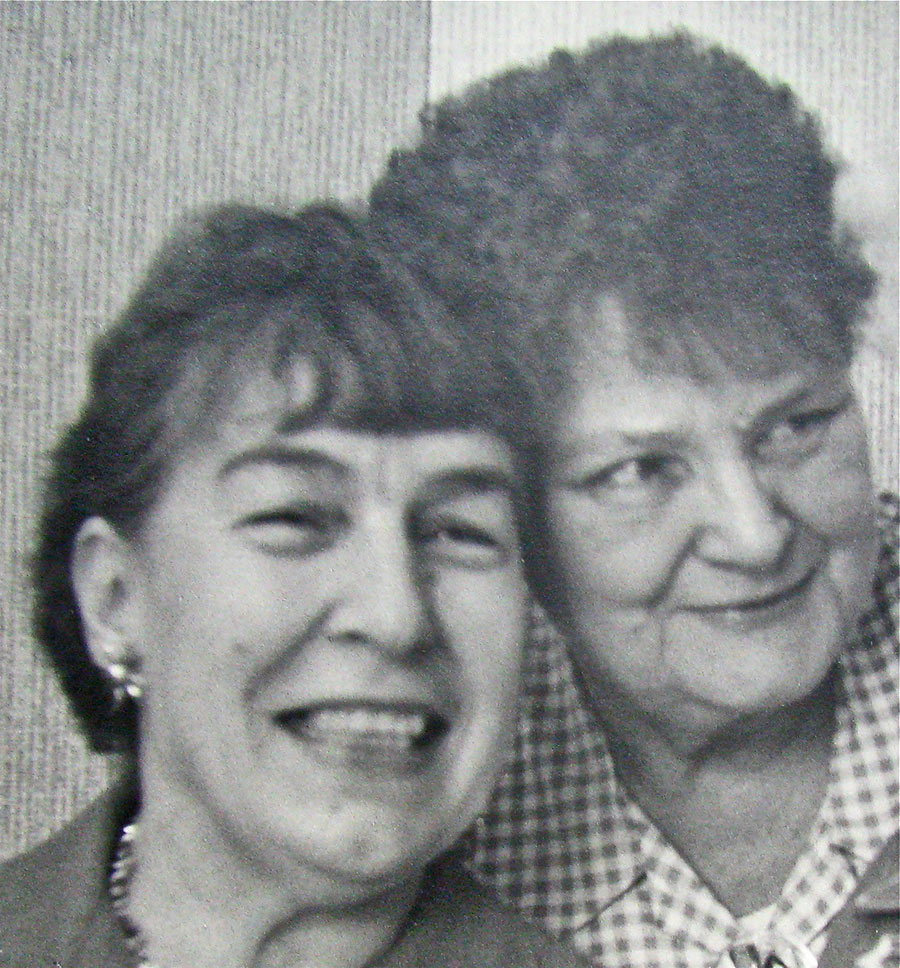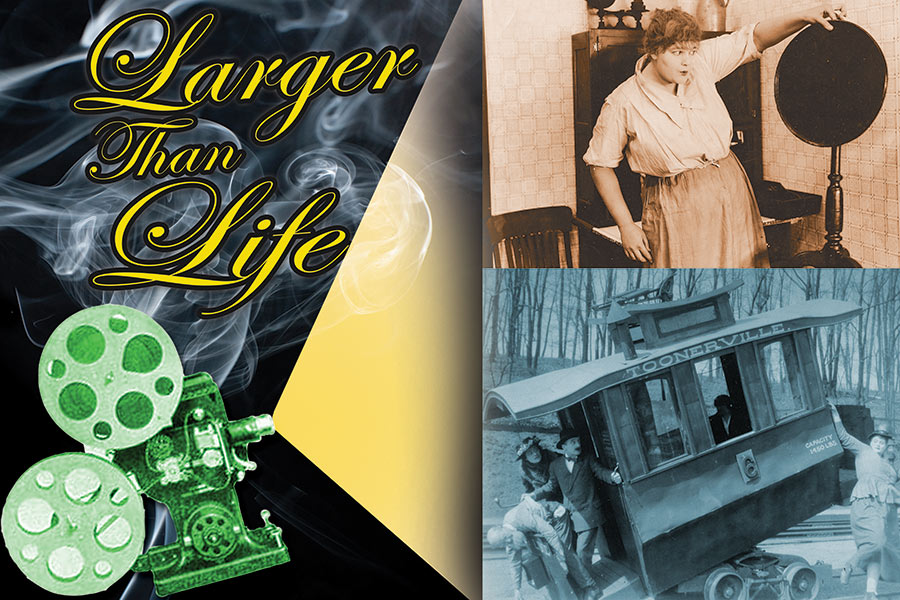Wilna Hervey’s story takes her from the Bronx to Pennsylvania to Woodstock to California to Florida and many places in between — and, nearly all the time, Nan Mason was by her side.
The women were a couple for nearly 60 years, having met through Hervey’s work as a silent-film star and going on to become prominent, accepted leaders in arts circles during the first half of the 20th century.
One local professor and silent-film aficionado is now looking to raise the curtain on the couple’s life and legacy.
Joseph Eckhardt, 70, an emeritus professor of history at Montgomery County Community College, has been researching the history of the local silent-movie industry for more than 35 years and began studying Hervey about eight years ago. Eckhardt recently published “Living Large: Wilna Hervey and Nan Mason,” a dual biography that will serve as a companion piece to the annual Betzwood Film Festival May 9 in Blue Bell, which this year will focus on Hervey.
Eckhardt, who is gay, is the founder of the Betzwood Film Archives, a digital history of the Betzwood Film Studios. The company, founded by Siegmund Lubin, was located along the Schuylkill River in what is now West Norriton Township and was one of the giants in the silent-film industry of the early 20th century.
One of Betzwood’s own larger-than-life figures was Hervey, who stood at 6-foot-3 and weighed 300 pounds. In 1919, Hervey was cast as The Powerful Katrinka in the “Toonerville Trolley” comedy series, which was based on a comic strip of the time.
“I was watching the ‘Toonerville’ films and that’s where I discovered Wilna Hervey. She has a way of standing out,” Eckhardt said. “But she was so intriguing. Here’s this enormous woman, with a very innocent look. I started to look into it and ask, Who is this woman? Where did she come from and what happened to her? As quickly as she appears in the movies, she seems to disappear.”
Eckhardt said it wasn’t easy to find information on Hervey. She didn’t use her family name and the name she did use was often misspelled.
He located a woman who lived in Woodstock, N.Y., who remembered both Hervey and Mason, and he later hit the jackpot when he found the “Wilna and Nan Papers” at the Archives of American Art in Washington, D.C.
“I hightailed it to D.C. to look through the papers. It was a treasure trove,” Eckhardt said. “Wilna was a packrat; she never threw anything away, literally. There were horror stories of people who cleaned out their house after Nan died but, fortunately, they saved what Wilna saved and donated all of the letters and materials.”
The archives contained thousands of letters between the women.
“It was their story, in raw form,” Eckhardt said.

Hervey and Nan Mason in 1924
Hervey was born to a music instructor and his wealthy wife, surrounded by material possessions as a child but few friends. Mason was the daughter of vaudeville actors who frequently moved throughout her upbringing.
In 1920, Mason was working as a stenographer and engaged to a man when she moved to Pennsylvania to live with her father, a “Toonerville” actor, until her wedding. That’s when she met Hervey.
“Both women had men in their lives when they first met and that fell by the wayside. It was conceivable that, without one another, Wilna would have continued her affair with a tempestuous Hungarian strong-man and Nan would have become the conventional, but unhappy, wife and mother,” Eckhardt said. “Their relationship transformed them. I think Nan was liberated by Wilna; she freed her to do things, try things. Conversely, Wilna’s mercurial nature was toned down by Nan. She kept her feet on the ground because Nan insisted on that. They had a wonderful relationship, which they each brought something different to.”
When Betzwood folded in 1921, Wilna and the Masons headed to California for new film ventures and the women ultimately headed back east, where they moved in together in Woodstock and set to work pursuing their artistic interests.
Through his research, Eckhardt said he found the couple was well-covered in the New York press from the 1930s-’50s.
“They became a high-profile couple in every sense of the word early on,” he said, noting that the women didn’t think of their relationship as something to hide or flaunt. “They would be incredulous at the idea of being ‘in’ or ‘out.’ That’s the kind of people they were. I don’t think it occurred to them that people might raise an eyebrow about the fact that they were a couple.”
That being said, however, Hervey and Mason had found the perfect place to live.
“If they tried to live in Podunk, Kentucky, in the ’20s, their story would have been very different. But Woodstock was a laidback community, full of eccentrics, as it is to this day. People didn’t bother anyone about what anyone else did, as long as they didn’t hurt anybody. That was the atmosphere they lived in. They became beloved members of their community.”
They also spent time in California, and were often shuttling back and forth between the two arts communities, befriending such noted film figures as Frank Capra and artists like Eugene Speicher and Henry Lee McFee.
“They lived in bubbles, I guess you could say,” Eckhardt said. “And I don’t think they were doing that to seek out a community where they would be accepted; it was just, as artists, these were the perfect places for them to live.”

Hervey and Mason in the 1960’s
Over the years, the women respectively took on various arts endeavors, from watercolors to switch-plate enamels. In the 1960s, they purchased a home in Florida, where they spent winters and worked prolifically in their studio; from the mid-’60s on, not a year passed without one of them winning an award for their artwork.
Following several years of declining health, Hervey died in 1979 in Florida, leaving her estate to Mason, whom she called her “friend of years” in her will. Mason died three years later.
Eckhardt said the most challenging aspect of penning the dual biography — which contains 180 vintage images depicting the women’s lives together and their artwork — was condensing their nearly six decades into a digestible recounting.
“The hardest thing was finding a path through it. The book could’ve been 10 times longer based on the material I had available,” he said. “I like to think of writing this book as taking a trip: You get on the road and you have to stay on the road to get to a certain place by a certain time, and it’s tempting to take side roads and see wonderful things but, if you do, you’ll never get where you’re going. I came to the conclusion I had to keep the focus on them as a couple, how they evolved and the arc of their story together.”
This was not Eckhardt’s first book-writing venture: In 1997, he wrote “The King of the Movies: Film Pioneer Siegmund Lubin,” a profile of Betzwood’s founder, as well as the 2011 biography “So Bravely and So Well: The Life and Art of William T. Trego.” He is currently collaborating on a full-length documentary film about Lubin.
Four of Hervey’s silent films will be shown at the May 9 film festival at Montgomery County Community College in Blue Bell, with live musical accompaniment, mirroring the film-watching customs of the ’20s. Eckhardt will give a lecture before the screenings about Hervey and Mason and sign copies of his book afterward.
Through all the work he invested in the project over the last several years, Eckhardt noted, the most impactful takeaway was the depth and dynamic of his subjects’ relationship, a topic that he said could be interesting to a vast audience.
“They had a wonderful relationship and were extremely devoted to one another. Had they not met, their lives would have been very different,” he said. “I think silent-film fans would be intrigued by the story, as well as people interested in art, because both women turned out some really unique pieces. Then there’s the inside view of Woodstock as a phenomenon and there’s obviously a draw for the LGBT community, who can learn about this previously unknown couple who had a remarkably happy and peaceful life as a same-sex couple.”
The Betzwood Film Festival begins 8 p.m. May 9 at 340 DeKalb Pike in Blue Bell. Guests can enter the parking lot off Morris Road and proceed to the Science Center Theater in the Science Center Building. Tickets can be purchased by phone at 215-641-6518 or at the door. For more information, visit mc3betzwood.wordpress.com/betzwood-film-festival/.
